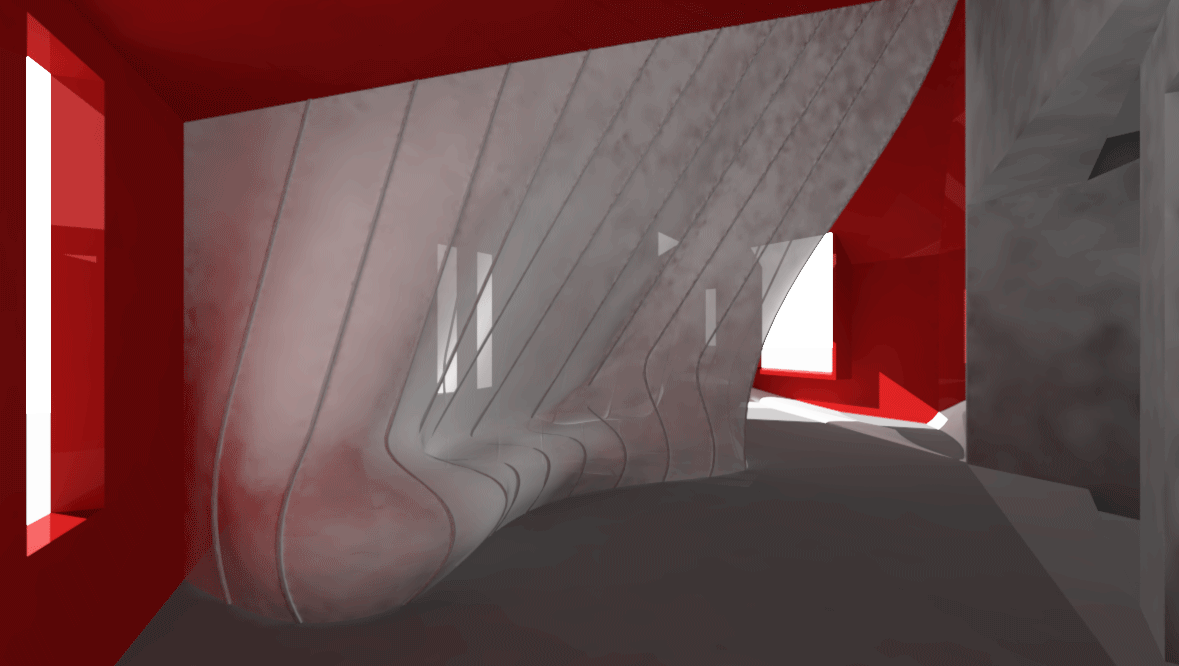skip to main |
skip to sidebar
______________________________final status update (part 2).following are snapshots of the parameters and constraints used to control the movement of the sma/fabric wall.1. with the extreme conditions of the fabric surface in plan drawn, i divided up the two splines into 20 points (representing 20 sma elements). i then drew lines from point to point in order to provide a movement guide for the vertical sma. i then placed a point on each line, controlled by the rendering ratio, so that the movement of each point along the line would be in line with the movement of the walls. the ratio parameter also accounts for the difference in length of movement of the 20 points, offerering a smooth transition. 2. from the points along the guide lines, i vertically projected a series of additional points to use as passing points for the vertical splines. these are controlled by a new user length parameter to allow for easy adapting later. the current heights are based on typical seating dimensions, as the sma fabric wall is envisioned as being a furniture element. a major factor in the design of this particular sma/fabric zone, is its flipping from interior to exterior. in the winter mode, the seat on the fabric is internal to the house (close to the heat of the hearth) while in the summer condition, the seat flips, orienting itself externally, in the shaded outdoor space. to allow for this, i created guides (similar to step 1) at the height of the seat and placed the spline passing point again controlled by the rendering ratio. therefore, the seat is able to flip from interior to exterior with the changing seasons. this will be shown in the final animation.
2. from the points along the guide lines, i vertically projected a series of additional points to use as passing points for the vertical splines. these are controlled by a new user length parameter to allow for easy adapting later. the current heights are based on typical seating dimensions, as the sma fabric wall is envisioned as being a furniture element. a major factor in the design of this particular sma/fabric zone, is its flipping from interior to exterior. in the winter mode, the seat on the fabric is internal to the house (close to the heat of the hearth) while in the summer condition, the seat flips, orienting itself externally, in the shaded outdoor space. to allow for this, i created guides (similar to step 1) at the height of the seat and placed the spline passing point again controlled by the rendering ratio. therefore, the seat is able to flip from interior to exterior with the changing seasons. this will be shown in the final animation. 3. i created the vertical splines by using the projected points from step 2 as reference points. i was having issues with the control of the bowing out of the spline, as i was using to few reference points. to fix this, i discovered that i could connect a spline to an existing straight line, in addition to the points. this allowed for the spline to have a much more rigid condition at the top, and a more flowing and soft shape at the base, where the seating is.
3. i created the vertical splines by using the projected points from step 2 as reference points. i was having issues with the control of the bowing out of the spline, as i was using to few reference points. to fix this, i discovered that i could connect a spline to an existing straight line, in addition to the points. this allowed for the spline to have a much more rigid condition at the top, and a more flowing and soft shape at the base, where the seating is.  4. i created the fabric by running a multi-section surface along the 20 vertical splines that i created. there were some issues of "cusping" occurring, so i had to make adjustments with the guides, as well as creating multiple multi-section surfaces at the severely twisting points, mainly at the point of the hearth.
4. i created the fabric by running a multi-section surface along the 20 vertical splines that i created. there were some issues of "cusping" occurring, so i had to make adjustments with the guides, as well as creating multiple multi-section surfaces at the severely twisting points, mainly at the point of the hearth. 5. with all of the points relating to the rendering ratio, precise location and movement is easily adjusted by changing the rendering position parameter.
5. with all of the points relating to the rendering ratio, precise location and movement is easily adjusted by changing the rendering position parameter.
______________________________final status update.i was able to get the vertical splines (which represent the sma's) working to move the fabric how i want it. creating a shifting indoor/outdoor seating condition in the crack portion of the house. below are two .gifs that show the motion and flipping of the seat.
i am gearing up for the final presentation on wednesday, so this is all the posting for now. i plan to have an overall roundup of the sketches and parameters i used in dp to create the motion i wanted, as well as having a few sheet drawings (utililizing the drafting component of dp) and finally a fully rendered animation (which is in progress through exporting .igs files into rhino) showing the shifting walls and sma/fabric condition. the ultimate goal is to continue to work on the dp model for the other fabric portions as well, to have a complete animation for the thesis review at the end of the month.view large for animations (there is a slight delay at the beginning). also, there is a flickr link in case the animations aren't working.
 flickr: elevation.
flickr: elevation. flickr: axon.
flickr: axon.















